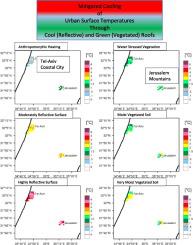Science of the Total Environment ( IF 8.2 ) Pub Date : 2020-07-03 , DOI: 10.1016/j.scitotenv.2020.140568 Barry H Lynn 1 , Icrat M Lynn 2

|
Experiments were conducted to assess the potential impact of cool and/or green roofs to mitigate summertime conditions in two cities of Israel, Jerusalem and Tel Aviv, which differ in elevation, humidity, and housing density. Tel Aviv is located along the coastal plain and characterized by low- and medium-density housing in a humid climate. Jerusalem is in the central mountains (elevation >750 m), and characterized by medium- and high-density housing in a dry climate. The fraction of potential roofs available for reflective cooling and the fraction of green versus impervious surface areas were estimated from “Google Earth.” Both were utilized as input into the Urban Canopy Model (UCM) within the Weather Research and Forecasting model, along with the residential building density. Increasing the albedo (cool roofs) had a larger impact on roof surface radiometric temperatures than covering the roof with irrigated soil and vegetation. Cool roof surface temperature differences were about 20 °C, compared to between 10 and 15 °C for wet soils with vegetation. The impact of varying albedo on 2-m. surface temperatures was about 0.4 °C, and the impact of varying soil moisture 0.1 °C. Increasing the leaf area index from 1.5 to 4.5 had a comparatively small impact on 2 m temperatures. Imposed anthropomorphic heating added about 0.2 °C to 2-m surface temperatures, which was less than values found in other studies conducted with more sophisticated building energy models. The surface temperature and heat index within Tel Aviv were more sensitive to mitigation efforts than those in Jerusalem, but both cities could benefit from mitigation efforts.
中文翻译:

耶路撒冷和特拉维夫市凉爽和绿色的屋顶对夏季温度的影响。
进行了实验,以评估凉爽和/或绿色屋顶对缓解以色列,耶路撒冷和特拉维夫两个城市的夏季条件的潜在影响,这两个城市的海拔,湿度和房屋密度有所不同。特拉维夫位于沿海平原,以潮湿气候中低密度的房屋为特征。耶路撒冷位于中部山区(海拔> 750 m),其特点是在干旱气候下的中密度和高密度房屋。可从“ Google Earth”中估算出可用于反射式冷却的潜在屋顶比例以及绿色与不渗透表面面积的比例。两者都被用作天气研究和预测模型中的城市冠层模型(UCM)的输入,以及住宅建筑密度。增加反照率(凉爽的屋顶)对屋顶表面辐射温度的影响大于用灌溉土壤和植被覆盖屋顶。凉爽的屋顶表面温度差约为20°C,而湿润的植被土壤温度差在10到15°C之间。反射率变化对2-m的影响。地表温度约为0.4°C,变化的土壤水分的影响为0.1°C。叶面积指数从1.5增加到4.5对2 m温度影响较小。强加的拟人化加热使表面温度增加了约0.2°C至2 m,这比使用更复杂的建筑能耗模型进行的其他研究中发现的值还低。特拉维夫的地表温度和热量指数比耶路撒冷的温度和热指数对缓解措施更敏感,











































 京公网安备 11010802027423号
京公网安备 11010802027423号